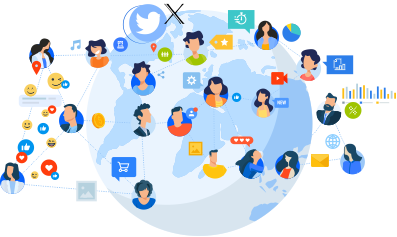
Twitter has its own set of unique features and benefits that can make a real difference for artists like you. Don't let its 280-character limit fool you—Twitter is a fantastic tool that offers a range of opportunities for scientific illustrators. Let's explore some of the exciting aspects that make Twitter a valuable platform for your work.
Staying up-to-date
First off, Twitter is known for its fast-paced, real-time nature. This can be a major advantage when it comes to staying up-to-date with the latest scientific discoveries, breakthroughs, and discussions. As a scientific illustrator, you can actively participate in these conversations by sharing your insights, asking questions, or even contributing visual explanations to complex scientific concepts. Twitter allows you to engage directly with scientists, researchers, and science enthusiasts from around the globe, fostering meaningful connections and collaborations.
Increased Visibility
Another great feature of Twitter is the use of hashtags. By using relevant hashtags like #SciArt, #ScienceIllustration, or specific subject-related tags, you can make your illustrations more discoverable to a wide audience. This can lead to increased visibility, interactions, and opportunities to connect with individuals who share a similar passion for science and art. Embrace the power of hashtags, and let your illustrations reach people who appreciate the beauty and educational value of scientific visuals.
Threaded Format
Twitter threads are an excellent way to present longer-form content, step-by-step processes, or in-depth explanations. You can break down complex scientific concepts into digestible chunks and accompany them with your illustrations. The threaded format allows your audience to easily follow along, engage with your content, and share it with others. It's a fantastic tool for educating and captivating your followers while showcasing your expertise as a scientific illustrator.
Sense of Community
Another aspect of Twitter that sets it apart is its ability to foster a sense of community. You can join conversations, follow like-minded individuals, and participate in science-related chats or events. By actively engaging with the scientific community on Twitter, you can build valuable connections, gain insights from experts, and stay informed about relevant trends or opportunities in the field.

The supportive and inclusive nature of the Twitter community can provide you with a strong network of peers, mentors, and potential collaborators.
Reach a Wider Audience
The retweet feature on Twitter allows your illustrations to reach a wider audience beyond your immediate followers. When your work resonates with others, they can easily share it with their own followers, exponentially increasing the reach and visibility of your art. This can lead to new followers, potential clients, or even opportunities to exhibit your work in science-related events or publications. Retweets are like the scientific illustrations' version of going viral—it's an exhilarating feeling to see your work being appreciated and shared by others.
Continuous Learning and Inspiration
Lastly, Twitter provides a platform for continuous learning and inspiration. You can follow influential scientists, science communicators, and fellow scientific illustrators, gaining access to a wealth of knowledge, resources, and artistic inspiration. The constant stream of information and insights can fuel your creativity, broaden your scientific understanding, and help you refine your skills as a scientific illustrator.
How To Create Impactful Tweets
That Grab Attention
Creating impactful tweets that grab attention can be a powerful way to engage your audience and spark meaningful conversations. Here's a friendly guide to help you navigate the process and make your tweets stand out:
1. Start with a hook:
Begin your tweet with an attention-grabbing hook. It could be a thought-provoking question, a surprising fact, a bold statement, or a captivating anecdote. The idea is to capture your audience's curiosity right from the start and entice them to read further.

2. Keep it concise:
Remember that Twitter has a character limit, so keep your tweets concise and to the point. Aim for clear and impactful messaging within the limited space. Craft your words carefully, using powerful language that resonates with your audience.
3. Use visuals:
Whenever possible, include visuals in your tweets. Scientific illustrations, diagrams, infographics, or eye-catching images can enhance the visual appeal and help convey your message more effectively. Visuals grab attention and make your tweets more shareable, increasing their potential reach.
4. Incorporate hashtags:
Hashtags are essential for increasing the discoverability of your tweets. Research popular science-related hashtags and use ones that are relevant to your content. This will help your tweets reach a broader audience and connect with people who are interested in similar topics.
5. Spark curiosity:
Craft your tweets in a way that piques curiosity and leaves your audience wanting to know more. Tease intriguing aspects of your scientific illustration or highlight a fascinating scientific discovery. By creating a sense of curiosity, you encourage your audience to engage, reply, and share your tweet.
6. Add value:
Provide value to your audience through your tweets. Share insights, tips, or interesting facts related to scientific illustration or scientific subjects in general. Aim to educate, entertain, or inspire your followers. When your tweets consistently offer value, you build credibility and a loyal following.

7. Encourage interaction:
Foster engagement by incorporating interactive elements in your tweets. Ask questions, conduct polls, or encourage your audience to share their thoughts and experiences. By inviting participation, you create a sense of community and encourage conversations around your tweet.
8. Be authentic and relatable:
Show your personality in your tweets. Be genuine, and let your passion for scientific illustration shine through. People appreciate authenticity, so share personal experiences or insights that resonate with your audience. Being relatable helps forge connections and encourages others to engage with your content.
9. Engage with others:
Don't forget to engage with others on Twitter. Reply to comments, participate in relevant discussions, and retweet interesting content from fellow scientific illustrators or scientists. Engaging with others builds relationships, expands your network, and increases the visibility of your tweets.
10. Track and analyze:
Use Twitter's analytics or third-party tools to track the performance of your tweets. Pay attention to metrics like impressions, engagement rates, and click-throughs. Analyzing your data helps you understand what types of tweets resonate the most with your audience, allowing you to refine your strategy over time.
Remember, the key to creating impactful tweets lies in capturing attention, providing value, and fostering engagement. Experiment with different approaches, be creative, and stay consistent. With time, you'll develop a tweeting style that grabs attention, sparks conversations, and helps you grow your presence as a scientific illustrator on Twitter. Happy tweeting!

Conclusion and Recommendations
While Twitter holds several advantages for scientific illustrators, it's important to recognize one potential drawback: the brevity of its format. With a limited character count, it can be challenging to provide comprehensive explanations or showcase intricate details of your scientific illustrations. The concise nature of Twitter may restrict your ability to convey the full depth and complexity of your work, particularly when tackling intricate scientific concepts.
Balancing succinctness with the need for accurate and informative visual representation can be a delicate task.
However, by leveraging threads and creative strategies, you can still make the most of Twitter's platform while navigating its character limitations to showcase your scientific illustrations effectively.
In a nutshell, Twitter offers scientific illustrators a dynamic space to engage with the scientific community, showcase our work through hashtags and threaded content, build connections, and find inspiration. It's a fast-paced platform that keeps you in the loop with the latest scientific developments while providing a supportive community that appreciates the intersection of science and art.
So join the conversation, share your stunning illustrations, and let the world marvel at the beauty of science through your visual creations!
